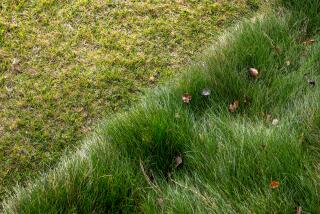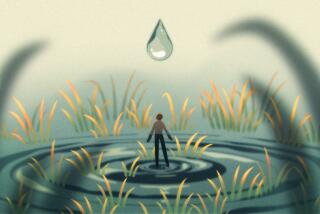As Grass Grows, So Does the Work
- Share via
A lifetime apartment dweller I know was thrilled when she and her husband moved into a house with a big yard. When she showed me around her new property, I agreed it was beautiful: half an acre of lush, green grass. She waxed rhapsodic about how she couldn’t wait to start planting tomatoes, herbs, lilacs and tulips. She thought it would be a great way to relieve stress.
I was skeptical. This is a woman who had never touched a shovel or pulled a weed in her life. How was she ever going to keep up with that lawn? But she assured me that she couldn’t wait to start doing yardwork.
Six months later, she felt different. As anyone who has ever had a lawn knows, the constant demands for upkeep take their toll. Each season has its own schedule. Planting, seeding, watering, clipping, spraying, raking, mowing. Unless you’re one of those rare people who truly loves to do yardwork, it can be a real grind. (And if you have someone else do it for you, it can be expensive.)
But my friend didn’t object to the work nearly as much as she disliked the environmental cost of her new hobby. She had assumed that working in her yard would bring her closer to nature. But it only brought her closer to chemical fertilizers, polluting weed killers and toxic bug sprays--not to mention the gas fumes from her spiffy new lawn mower.
In fact, my friend had good reason to be concerned. According to the National Gardening Assn., Americans now spend close to $8 billion a year on residential lawn care, much of it environmentally destructive.
She was also bothered about how much water she used to keep her grass green. In an era when water conservation is an environmental priority, she had a hard time justifying using so much water on her personal plot of land.
I’ve been suggesting to people for a long time that a good way to simplify life is to get rid of the lawn. When I first mention it, there’s usually a lot of resistance. As one man asked, “Wouldn’t it be ugly if everyone had plots of green concrete?” But getting rid of your lawn doesn’t have to mean subjecting yourself to a barren wasteland.
Here are some better ideas:
1. Replace your lawn with some ground-hugging, low-maintenance shrubs, perhaps interspersed with gravel or decorative bark.
2. Plant drought-tolerant ground covers. Check with your local nursery to find one suitable for your locale.
3. Put your indoor plants to better use by bringing them outside. Keeping plants indoors requires time-consuming upkeep. Return them to nature.
4. If you’re not willing to give up your lawn altogether, start making some changes in the upkeep.
For example:
* Have a smaller lawn.
* Let your grass grow taller--a closely cut lawn requires more watering, and the grass develops less healthy roots. Start a new trend in your neighborhood.
* Keep grass clippings and leaves in the lawn as natural fertilizers.
* Stop using chemical pesticides. Investigate organic lawn-care products.
The next time you move, look for a house with no lawn so you can get your Saturday mornings back.
* Elaine St. James is the author of “Simplify Your Life” and “Simplify Your Life With Kids.” For questions or comments, write to her in care of Universal Press Syndicate, 4520 Main St., Kansas City, MO 64111.






